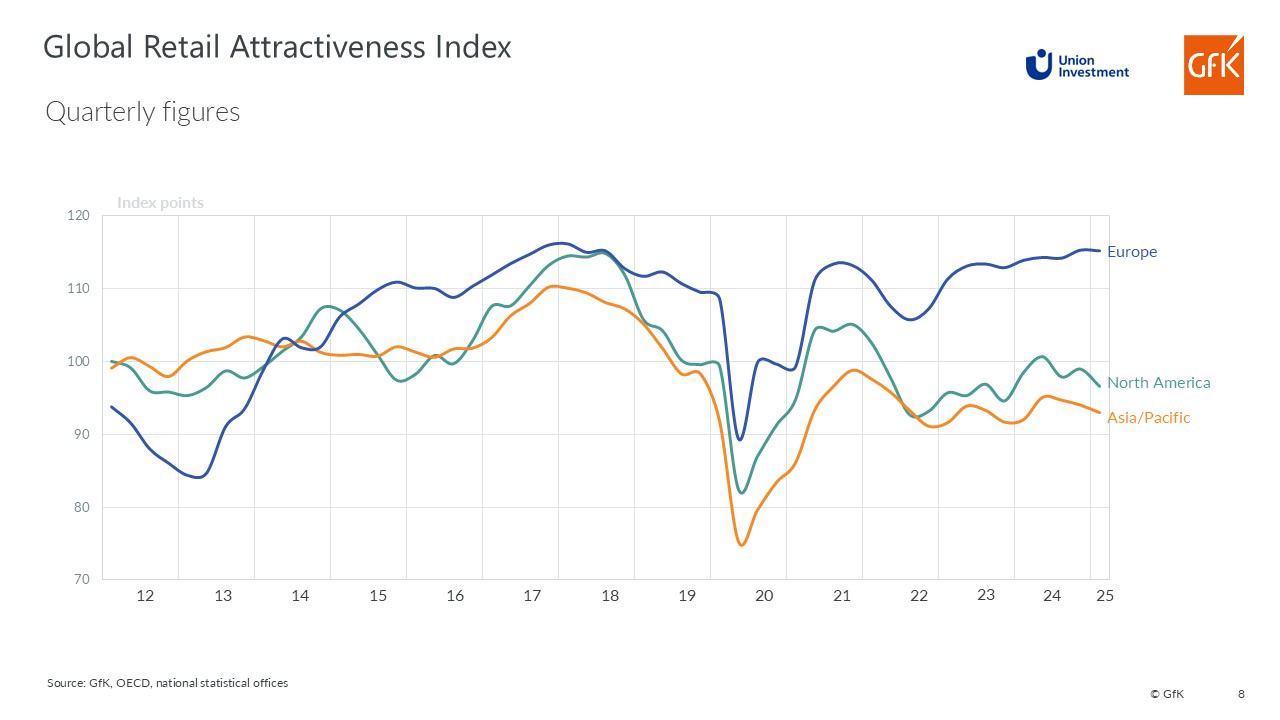2025-05-28
retail

GRAI 1/2025 confirms the positive trend in the first quarter of 2025. The EU-15 Index, compiled by Union Investment and GfK, reached a new high of 115 points, reporting further growth in seven European countries. However, trade tariffs and weakening GDP growth may have a temporary negative impact on trade. The European retail markets have moved beyond the trough of 2022. The brighter mood among retailers and consumers, as well as the healthy fundamental data, is reflected in the 115 points reached by the Global Retail Attractiveness Index (GRAI) for Europe in the first quarter of 2025. With a further one-point increase compared to the previous year (first quarter of 2024: 114 points), the recovery that began three years ago is expected to continue in 2025. By spring, the index calculated by Union Investment and Gfk had even reached a new high since the first survey seven years ago (2018). The slight to strong upturns in seven European retail markets contributed to a more “green” European map throughout the year. In two other markets, figures stabilized at the same levels as the previous year. Growth was robust in the Czech Republic, with a twelve-point increase, and in Sweden, with a seven-point increase. Poland remains the current leader in the EU-15 index with 136 points despite a slight drop. The Czech Republic (129 points) and Portugal (121 points) also remain among the top trio. The German retail market maintained its good level in the first quarter with a stable 112 points, while Austria showed a trend reversal with a substantial increase of five points, reaching 97 points. In addition to Poland and France (both with 110 points), only Denmark (92 points) and Finland (93 points) saw declines, primarily in the low single-digit range. The two Nordic countries thus bring up the rear in the current European ranking. “The majority of European retail markets are stronger three years after the crisis, with healthy fundamentals, above all rising retail sales, and intact labor market figures. Accordingly, we are also seeing improved sentiment among institutional investors, who are increasingly exploring opportunities to enter the retail sector again,” says Henri Eisenkopf, Director Transactions Shopping Places at Union Investment. “After initially focusing on properties with value appreciation potential, investors in Europe are now increasingly looking for core properties across the entire retail spectrum, including shopping centers. For us as investment and asset managers, the current market phase with its positive trend in the operating performance of retail properties promises attractive yield contributions in the portfolio as well as good opportunities for profitable sales.” While the European retail markets have emerged from the crisis, development in North American markets is still lagging. Above all, however, the Asia/Pacific region is still lagging well behind Europe. The North America index in the GRAI deteriorated slightly by two points over the year, reaching an average value of 97 points at the end of the first quarter of 2025. The Retail Index in Asia/Pacific rose by one point, but still only reached a below-average level of 93 points. “Overall, it should be noted for the coming months that trade tariffs and a weakening GDP trend could hurt trade, at least temporarily,” says Henri Eisenkopf.

